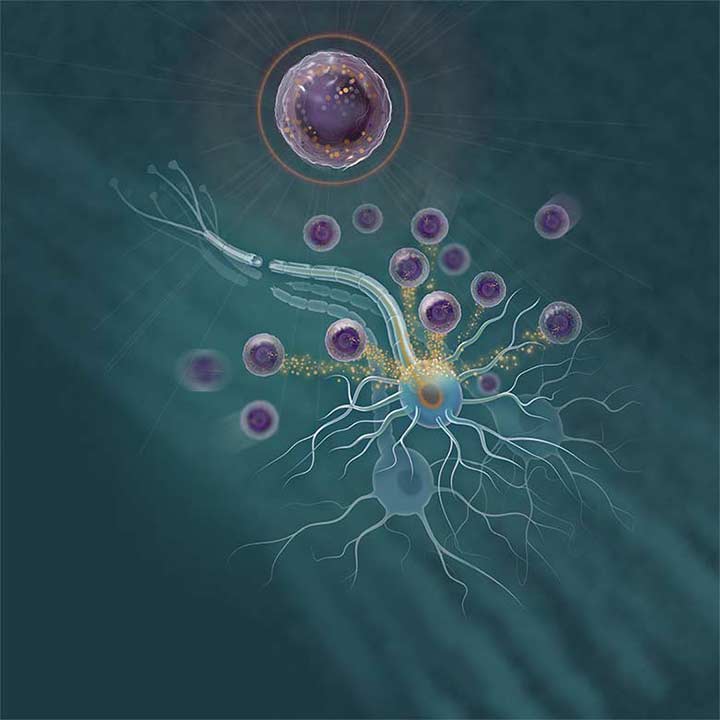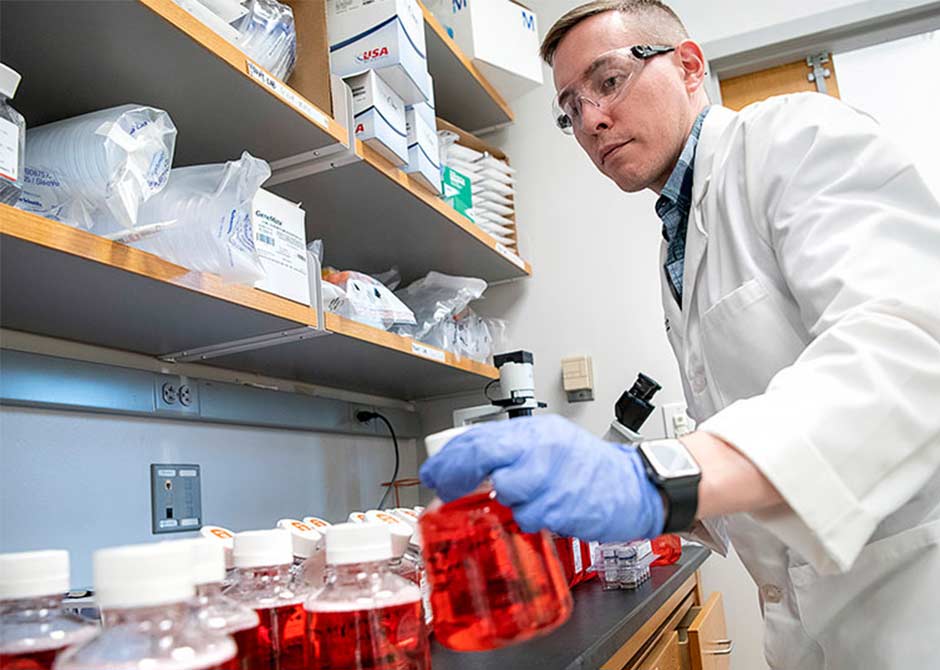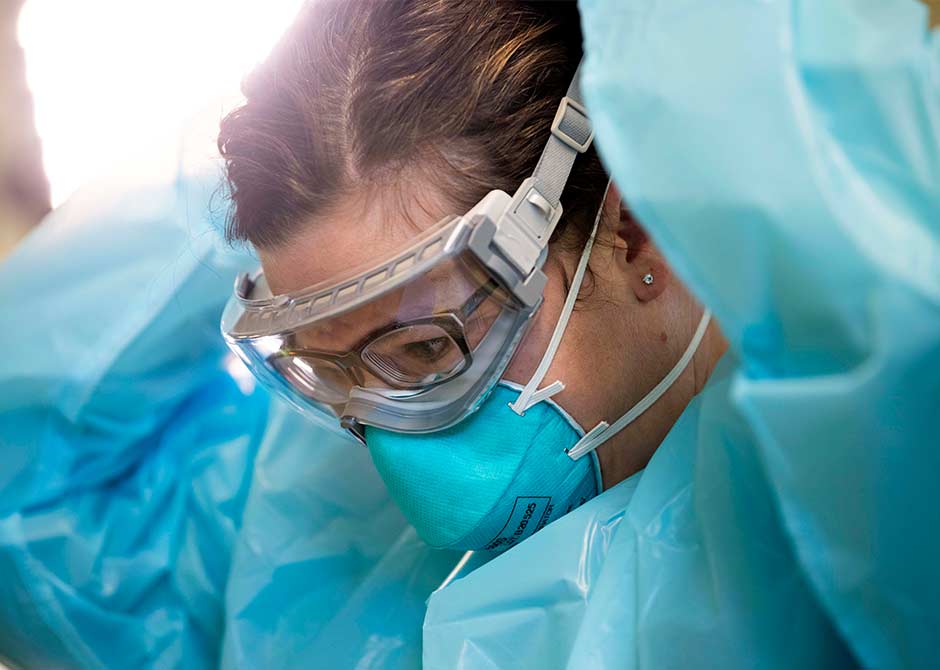
Finding neurology's 'holy grail'
Each day, faculty, researchers and learners at The Ohio State University College of Medicine bring together expertise and drive to advance innovations and solve unrelenting medical and health care challenges. Discovery and transformation are methodical and measured; solutions don’t often appear overnight.
Unless the world is in the grips of an unprecedented global pandemic.
Never before in history has the leadership, passion and determination of so many innovators been mobilized as rapidly and efficiently, and in some cases in a matter of days, as during the pandemic.
It took the work of many to create solutions to save lives and model to others how to face COVID-19 head-on. Ohio State has led COVID-19 prevention and treatment efforts from mass vaccination sites and post-COVID-19 recovery care, to record delivery of monoclonal antibody infusions that kept patients out of hospitals, and research on the long-term impact of COVID-19 on first responders and health care workers.

The Ohio State College of Medicine is a long-standing site for clinical trials that test the safety and efficacy of new treatments for HIV/AIDS, cancer and many other medical diseases. Expertise in collecting and analyzing complex datasets and existing infrastructure enabled the academic institution to quickly respond to the reality of COVID-19 on the ground. Teams of researchers and clinicians came together to provide evidence-based treatment for high-risk patients with mild to moderate cases of COVID-19.
In addition to the more than 100 COVID-19-related studies underway across the university, COVID-19 vaccine clinical trials and early trials on the safety and efficacy of monoclonal antibody infusions have been taking place on campus since the first days of the pandemic.
Monoclonal antibody infusions are laboratory-made proteins that mimic the immune system’s ability to fight off harmful antigens such as viruses. They can attach to the spike protein on the surface of the virus and block it from invading human cells. Among multiple treatments that have been evaluated at the Ohio State College of Medicine, researchers studied an antibody therapy by Eli Lilly called bamlanivimab, which was specifically directed against the spike protein of SARS-CoV-2. It was proven in trials to shorten the duration of the illness and significantly reduce serious complications that could lead to hospitalization.
Carlos Malvestutto, MD, MPH (external link), assistant professor in the Division of Infectious Diseases (external link), and Jonathan Parsons, MD (external link), professor in the Division of Pulmonary, Allergy, Critical Care and Sleep Medicine (external link), co-chair Ohio State’s COVID-19 Outpatient Monoclonal Antibody Program. They mobilized a team of experts in pulmonology, pharmacology, epidemiology, nursing and information technology to convert an existing space into a freestanding infusion center that separated the intake of patients with active cases from non-COVID-19 patients. This facilitated safe administration of anti-spike protein monoclonal antibodies to those who met the criteria.
“The U.S. Food and Drug Administration issued an Emergency Use Authorization for their use in vulnerable patient populations on Nov. 9, 2020,” says Dr. Malvestutto. “Seven days later we gave our first infusion in an auditorium that we turned into an infusion site.”
The Outpatient Monoclonal Antibody Program team continuously reviews clinical trial data, internal utilization and clinical outcomes to optimize the impact of monoclonal antibodies in high-risk individuals treated at Ohio State.
To ensure the effectiveness of the treatment, an eligible patient must receive a positive test result, obtain a referral from a primary care physician to schedule an appointment and then come in to receive an infusion at the designated site as soon as possible, ideally within seven days of the onset of symptoms.
To maximize success within this time constraint, Ohio State leveraged its electronic health records to identify and fast track its high-risk patients and treat them in record time.
“By anticipating the needs of these high-risk patients, we facilitated same-day referrals and have been scheduling infusion appointments within 24 hours of referrals,” says Dr. Malvestutto. “Workflows are also in place to administer infusions for COVID-19 patients who arrive in our emergency departments within the allowed time period and meet the high-risk criteria.”
Ohio State continues to lead the way in effective prevention and treatment for Ohioans impacted by the pandemic. As of Oct. 1, 1,750 patient infusions have been administered at Ohio State, and internal data shows that the efforts reduced the risk of COVID-19-related emergency department visits and hospitalizations in high-risk individuals by more than 50%.
In response to the current surge in COVID-19 cases driven by the high transmissibility of the delta variant, operations have been ramped up once again to provide infusion treatment to all eligible patients seven days a week.
The Emergency Use Authorization for the antibody cocktail casirivimab/imdevimab has recently been expanded to provide monoclonal antibodies as post-exposure prophylaxis. This indication is based on data also collected in clinical trials at Ohio State and is particularly important for immunosuppressed patients who may not be able to mount an adequate immune response to COVID-19 vaccines.
“This is a game changer for all patients with underlying conditions and compromised immune systems who are exposed to COVID-19,” says Dr. Malvestutto. “Instead of quarantining, waiting and hoping they don’t develop severe disease, these patients can receive proactive treatment that will greatly reduce their risk of acquiring COVID-19.”
Foresight, science and determination led a group of scientists to develop, test and gain authorization for emergency use of vaccines to combat COVID-19 in record time. Fast action and dedication on the part of experts at the Ohio State College of Medicine and The Ohio State University Wexner Medical Center made it possible to deliver vaccine doses that hold so much hope into patients’ arms as soon as possible.
Ohio State became one of the first hospitals in the nation and the first in Ohio to administer the first round of COVID-19 vaccine doses to frontline workers, in December 2020. Unlike other health care systems that prioritized physicians, Ohio State determined who would receive these coveted first doses based on location and exposure risks to COVID-19 rather than their job description.
As vaccine supply ramped up across the state, Ohio State quickly mobilized vaccination clinics at three locations across its Columbus campus. Then, as eligibility for the vaccine expanded, Ohio State transformed the 770,000-square-foot Jerome Schottenstein Center–home to a number of Ohio State athletics teams–into a mass vaccination site in a matter of 10 days. Over four months, operating six days a week and 12 hours a day, more than 200,000 patients maintained social distancing protocols while moving efficiently through the arena to receive their vaccinations.
Dr. Parsons served as the physician in charge of on-site operations. He saw firsthand the teamwork and dedication it took to pull off 223,000 patient visits so successfully.
“From security to registration to clinical and nonclinical staffing, infection prevention and communications, everyone came together to safely administer vaccines on a massive scale,” says Dr. Parsons. “It was very rewarding to play a part in helping our partners, our community and our families take an important step toward returning to normalcy.”
The study of pathogens and how our immune systems protect against them has shown that vaccines are among the most powerful tools we have against viruses. Data shows that the vaccines against COVID-19, even against the highly contagious delta variant, have proven to be safe and effective for millions of people. Ohio State is equipped to deliver COVID-19 booster shots as more people become eligible.
The U.S. Food and Drug Administration (FDA) granted full approval of the vaccine, which Dr. Parsons says could instill additional confidence in others to get vaccinated.
“Full FDA approval is another milestone that brings us one step closer to controlling this pandemic,” says Dr. Parsons.
Every time SARS-CoV-2–the virus that causes COVID-19–infects a person, minute changes occur in the virus’s genetic code. All coronaviruses rely on the genetic component called RNA, which are prone to mutations as the virus replicates in the body and moves on to infect another person. Most of these mutations don’t change the behavior of the virus or alter it in negative ways. But sometimes they bring about change that emboldens or gives the virus a new advantage, like making it more apt to stick to or penetrate immune cells.
Daniel Jones, MD, PhD (external link), professor of Pathology in the Ohio State College of Medicine, and his research team have been at the forefront of COVID-19 research from day one. In March 2020, his team started sequencing the genetic material of samples from infected patients to begin tracking the virus. When they noticed an uptick in similar mutations across samples, it led them to identify the evolution of a specific strain in the United States, now called the “Columbus strain,” which contains three mutations that hadn’t previously been seen together in SARS-CoV-2.
“Sequencing allows us to continuously evaluate the viral genome,” says Dr. Jones. “By sharing our findings and comparing notes on viral strains with scientists around the world, we track its evolution in real time.”
By making these discoveries early, Ohio State scientists have a clearer line of sight to be able to make decisions based on scientific data versus speculation.
Peter Mohler, PhD (external link), vice dean for Research at the Ohio State College of Medicine and chief scientific officer for The Ohio State University Wexner Medical Center, says that Ohio State researchers have uncovered evidence that current vaccines will continue to be effective against these identified new strains, but variations in the future could begin to reduce the effectiveness of current therapies.
“As the number of people with immunity grows through natural infections and vaccinations, it will put pressure on the virus to evolve,” says Dr. Mohler. “Continuing to track it will lead to more scientific breakthroughs in prevention and treatments that will save lives.”
For some patients at the Ohio State Wexner Medical Center (external link), beating an initial acute infection from the virus is not the end of their COVID-19 road. As they recover and get ready to leave the hospital, many take with them fatigue, shortness of breath, headaches, chest pains, palpitations and dizziness.
Researchers at the Ohio State College of Medicine have tracked how COVID-19 can ravage the body in a variety of ways, resulting in damage to the lungs, heart, nervous system, kidneys, liver and mental health. That led us to establish a transition of care clinic to connect patients with advanced practice providers, pharmacists and behavioral health providers as they continue to navigate a new normal brought on by lingering symptoms.
Brooke Bellamy, BSBA, senior director of Access and Capacity Management at the Ohio State Wexner Medical Center, says 250 patients have been seen since Oct. 1 with what’s being coined long COVID, or post-acute sequelae of SARS-CoV-2, and the department has arranged 1,178 transition of care appointments.
“Our main goal is to support patients long-term and lessen readmissions to the hospital,” says Bellamy. “It is one thing to recover from COVID, but a whole other set of support is required for care coordination and patient advocacy to manage ongoing symptoms.
“Often it takes patients a bit of time to navigate grief, pain and traumatic stress from battling COVID,” says Bellamy. “As the pandemic continues, behavioral health support is difficult to engage with, so our being able to fast-track support is a huge help.”
 Large research grant funds ongoing study of virus's long-term impact on frontline responders
Large research grant funds ongoing study of virus's long-term impact on frontline respondersFrom day one, first responders and health care workers have been on the front lines in the fight against COVID-19, putting them at high risk for exposure and re-exposure. They’re now at the forefront of research being conducted by the Ohio State College of Medicine on the long-term, longitudinal impact of COVID-19.
A five-year, $10 million grant from the National Cancer Institute (NCI) in the National Institutes of Health is funding the Center for Serological Testing to Improve Outcomes from Pandemic COVID-19 (STOP-COVID). The center is integrated with the broader NCI Serological Sciences Network, which uses serological and molecular tests to better understand the immune response to COVID-19. Serological testing enables researchers to examine a blood sample for antibodies to determine if an individual has had a past infection with a virus or COVID-19 vaccination.
By studying this specific population and their immediate household contacts over a five-year period, researchers aim to provide answers to looming questions regarding antibodies, vaccine effectiveness, breakthrough and recurrent infections and whether or not past infection with a similar virus, like the common cold, provides any level of immunity against COVID-19 or worsens symptoms.
“COVID-19 is a moving target,” says Eugene Oltz, PhD (external link), professor and chair of the Department of Microbial Infection and Immunity (external link) at the Ohio State College of Medicine. “Understanding why some people are more at risk for infection and re-infection, or are symptomatic or asymptomatic, will enable us to adapt treatment protocols as we continue to face new variants.”
Dr. Oltz serves as co-principal investigator along with Ashish Panchal, MD, PhD (external link), professor of Emergency Medicine (external link); Ann Scheck McAlearney, ScD (external link), Distinguished Professor in the Department of Family and Community Medicine (external link); and Linda Saif, PhD, MS (external link), Distinguished University Professor in Ohio State’s Department of Veterinary Preventive Medicine in the College of Veterinary Medicine (external link).
The team has built a robust system of recruitment, with the aim of gathering 2,000 participants. When participants join the study, they first fill out a survey, then they receive a COVID-19 test and a blood draw to measure levels of antibodies specific for the virus.
“For those coming in contact with sick patients and community members on a daily basis, receiving results of their viral and antibody status within a day is a huge relief,” says Dr. Panchal. “It also helps us keep close tabs on disease prevalence, which is the first phase of the project.”
Phase two of the study involves serological testing and analysis to determine the cellular makeup, viral load and antibodies in these samples. From there, researchers are able to determine how well existing antibodies can protect against or neutralize emerging variants. Further, by studying patient responses to infection versus the vaccine, they can determine how durable the responses are in comparison.
The final phase of the study is to translate the scientific findings and evidence into practice by developing tools and communication best practices to combat misinformation and distrust in the safety and efficacy of vaccines. It will also enable greater understanding of how science dictates policy and informs new recommendations.
The three phases are concurrent, allowing the team to pivot and solve questions as the virus continues to evolve.
“We have been able to answer new questions by pivoting at the recruitment and data analysis stages,” says Dr. McAlearney. “We can recruit patients with certain histories, work to make sense of these histories and determine how they may impact protection.”
The team has compiled data from surveys and interviews on vaccine hesitancy in certain populations, such as firefighters, EMTs and paramedics. They’ve surveyed high-risk individuals, including those undergoing treatment for cancer, to assess the likelihood of their receiving the newly available booster shot.
Ohio State has some of the best minds in virology, immunology, serology, technology, internal medicine, emergency medicine and health services research working, mostly virtually, to manage this huge undertaking. Dr. Saif says the pandemic may prevent them from working and meeting together in person, but it has not deterred discovery and innovation.
“We have the infrastructure and bandwidth to accomplish the goal of stopping the spread of COVID-19.”